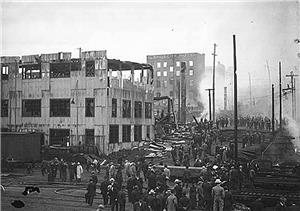This file contains Seattle historian and photographer Paul Dorpat's Now & Then photographs and reflections on a terrific fire that burned from the Seattle waterfront into Belltown on the night of June 10, 1910.
The Photographs
Looking down Seattle's Wall Street through the ruins of the 1910 Belltown fire we note what was then still a commonplace of street life. The men all wear suits and hats and apart from the two women in the foreground there are no others to be seen. Early in 1962, the 530-foot-long Galbraith Bacon dock seen in the "then" photo was cleared for the construction of the Edgewater Inn, which opened in the spirit of if not in time for the opening of Seattle's Century 21 World's Fair.
The Fire
Pushed by a 40-mph gale off Elliott Bay, one of the city's greater historic fires swept east from Railroad Avenue (Alaskan Way) into Belltown on the night of June 10, 1910. The fire started on the east side of the wide waterfront trestle, but did little damage to Railroad Avenue itself and none to the wharves over the Bay. Without the cooperation of the wind, the Galbraith Bacon Wall Street Dock might have easily been consumed and the all the railroad traffic moving north from Seattle halted.
By 1910, James Galbraith and Cecil Bacon were old hands on the waterfront. Following Seattle's "Great Fire" of 1889, Galbraith began dealing wholesale grain, hay, plaster, and concrete in a small wharf near the foot of Washington Street. In 1900, he moved with Bacon to the new Pier 3 (renumbered 54 during World War II, and home of Ivar's Acres of Clams restaurant since 1938) and prospered so that the partners soon moved north again to the also new Pier 67 at the foot of Wall Street.
The Wall Street Pier and part of the Galbraith Bacon sign along the crest of the pier shed can be seen here through the filter of the still smoldering fire around noon of the following day. With the memory of Seattle's "Great Fire" only 21 years old, and with this fire as with that, the ruins attracted sightseers -- like these -- and in 1910 there was no need to stop them if they kept to the streets.
There were ruins. Near its start the fire destroyed the Galbraith Bacon storehouse and stables, and the entire block bordered by Railroad and Elliott avenues and Battery and Wall streets. It also gutted the four-story brick Glenorchy Hotel on Western Avenue north of Wall, four apartment houses, two restaurants, a hardware store, and much else including more than a dozen residences. When it was roaring through the night, the light from the fire lit up the town and those who watched it progress were certain that the north end was doomed. But a sudden rain and quieting of the wind stopped it all.
By chance, 1910 was the year that the first motorized fire apparatus was put in operation here, but to little effect with this fire. That year there were still 38 livery stables listed in the city directory. The first demonstration of flight was given here in 1910 and the plane promptly crashed in a small lake in the Duwamish Valley. A local reporter advised, "Girls, if you marry for money pick an old man or an aviator." That year Hi Gill was elected mayor and opened the Skid Road south of Yesler Way to gambling, prostitution, and police payoffs that benefited his Chief Charles "Wappy" Wappenstein. The following year the newly enfranchised women recalled Gill and "Wappy" was sent to the pen.

